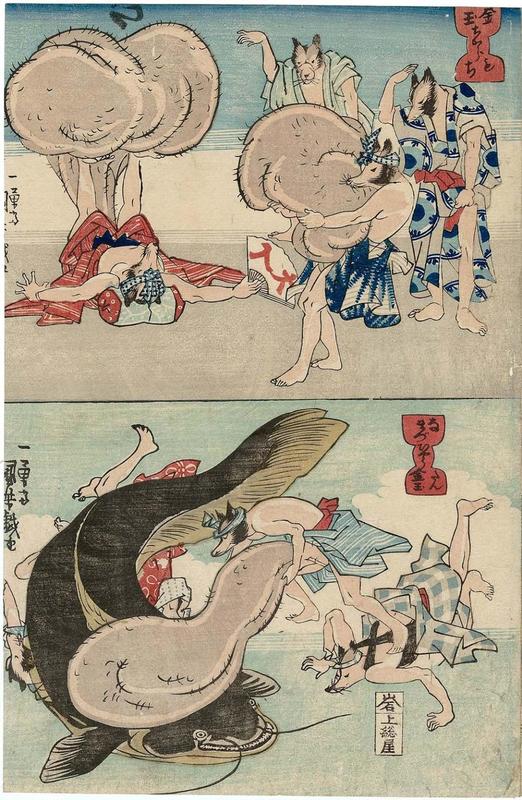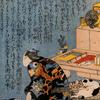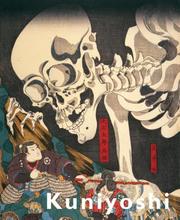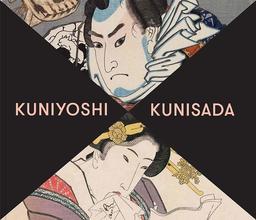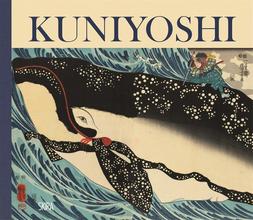More about Weightlifting and Catfish and Gourd
- All
- Info
- Shop

Sr. Contributor
Although you may not be accustomed to seeing racoon-dogs that use their engorged testicles for both weightlifting and battle, for Utagawa Kuniyoshi and his Japanese brethren, this is just another scene of tanuki tomfoolery.
The tanuki are a species of racoon-dogs from Japanese folklore that is still popular today. These special creatures have scrotums that they can grow at will and use in many ways – because why not? Maybe Matthew Barney was channeling the tanuki’s big scrotum energy when he conceived of the Cremaster Cycle.
You may be surprised to learn that tanuki are not only real, but they’re also cute as heck. Unlike their artistic counterparts, real tanuki are small, fluffy creatures that are more related to dogs and wolves than raccoons, despite their trademark masks. The tanuki inspired an interesting artistic tradition that began as early as the year 720. The fictional tanuki of Japanese folklore are pranksters that wield their testicles for uses as far as the imagination can stretch: as an umbrella, as weights, and even as fishing nets. Has there ever been such an imaginative animal with a multi-faceted body part? My guess is no.
After Japan opened its ports to the world in 1853, the country’s art – especially its extremely flat, woodblock-printed images – inspired Europeans like Whistler and Monet, who took cues from the Japanese and ran with them. Unfortunately, the United States took a bit longer to get on this train. We can thank William Sturgis Bigelow – a young, rich, and disaffected American doctor – who traveled to Japan in 1882 in search of more than his privileged, Bostonian upbringing. What was meant to be a short vacation ended up lasting for seven years. When Bigelow’s father telegraphed him to return to Boston, Bigelow rebelled and by staying longer and longer. Take that, dad.
Bigelow fell in love with Japanese culture and art, ascribing to Buddhism and amassing a huge art collection. During his stay, he bought over 40,000 ukiyo-e prints and eventually donated this impressive collection to the Museum of Fine Arts, Boston, to clear up any bad blood upon his return to the United States. This deal worked out for both parties. The museum got a truckload of Japanese art that they would not have acquired otherwise, and Bigelow eventually replaced his father’s seat on the museum’s board of trustees. Today, Bigelow’s collection accounts for a whopping eighty percent of all the works by Hokusai in the museum’s holdings. Bigelow’s impressive collection opened American eyes to Japanese art. We’re thankful he did, because how else would we have learned about tanuki?
Sources
- Ives, Colta. “Japonisme.” In The Heilbrunn Timeline of Art History. Department of Drawings and Prints. The Metropolitan Museum of Art. October 2004. https://www.metmuseum.org/toah/hd/jpon/hd_jpon.htm. Accessed 28 May 2020.
- Museum of Fine Arts Boston. “Weightlifting.” Collection. https://collections.mfa.org/objects/461388/. Accessed 28 May 2020.
- The Massachusetts Historical Society. “William Sturgis Bigelow.” From Our Cabinet: Order of the Rising Sun. May 2002. https://www.masshist.org/objects/cabinet/may2002/bigelow.htm. Accessed 28 May 2020.
- Roger Warner. “Seeing Hokusai in Boston? Thank this eccentric Brahmin.” Boston Globe. 29 March 2015. https://www.bostonglobe.com/magazine/2015/03/26/seeing-hokusai-boston-t…. Accessed 28 May 2020
- White, Chris. “Tanuki the Tipsy Tricker.” Articles. 6 March 2014. https://www.atlasobscura.com/articles/the-tanuki-japan-s-trickster-god. Accessed 28 May 2020.
- Li Zhou. “Japanese Pet-Raccoon Craze Threatens its Wild Dogs.” The Atlantic. 1 February 2016. https://www.theatlantic.com/science/archive/2016/02/raccoons-dogs-tanuk…. Accessed 28 May 2020.
- Zoo Atlanta. “Tanuki.” Animals. https://zooatlanta.org/animal/tanuki/. Accessed 28 May 2020.

